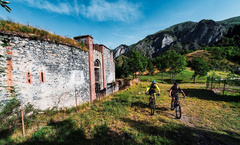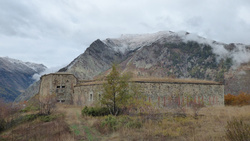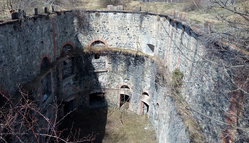Among the many tourist resources the valley offers, one of the most surprising is certainly Forte Albertino in Vinadio. Built in the mid-19th century with the aim of barring access to the Cuneo plain from the Colle della Maddalena, but it was never used for war purposes, when it was inaugurated the fort had a barricade line that was more than a kilometre long, divided into three parts: the attack front (the current entrance to the fort), the lower front (now used as an event space) and the upper front (which now houses the Museo Montagna in Movimento).
Today, the imposing structure is literally divided in half by the state road that runs through the valley and encloses within it - unique in Italy - part of the village where a network of barracks, walkways and gun and artillery emplacements are located. Thanks to important valorisation and recovery programmes, the structure today represents an important cultural centre, not only for the valley. It houses the Museo Montagna in Movimento, a work by the famous sculptor David Mach, the work "Circle" by Richard Long, a historic English artist and exponent of the "Land Art" movement, and an event space that in winter turns into an ice-skating rink and a campsite. Not far from the walls is a small artificial bathing lake.
VINADIO – Fort Albertino
Piazza Vittorio Veneto n. 8 - 12010 Vinadio CN
INFO
www.fortedivinadio.com
mail: info@fortedivinadio.com
tel: 340.4962384. - Fondazione Artea
THE 19TH CENTURY FORTRESSES



In addition to the famous Forte Albertino (Fort Albertino) in Vinadio, there are other forts built in the late 1800s and early 1900s.
The most significant are Forte Neghino (Fort Neghino), the Batteria Serziera (Serziera Battery), the Batteria Piroat (Piroat Battery), the Caserma Difensiva Sources (Sources Defence Barracks) and the Caserma Comando Vinadio.
Forte Neghino was a protective fortification manned by 100 men. Its function was to cover the flank of Forte Vinadio, stopping the enemy from descending from the Vallone di Neraissa (Neraissa Valley) and above all to occupy the strategic position of the Podio. In the early 1890s, it was supplemented by an external Battery for four mortars.
The Batteria Serziera (Serziera Battery) was a protective battery manned by 140 men, its function was to cover the flank of the Forte di Vinadio (Fortress of Vinadio), extending the Piazzaforte's range of action towards the stretta di Pianche and into the Vallone di Rio Freddo.
The Batteria Pierot (Piroat Battery) was also a semi-permanent battery in barbette, lacking troop quarters (except for a guardhouse) and facilities for close defence. It had a defiladed underground powder magazine, connected to the piece line by an underground tunnel equipped with a Decauville line for ammunition transport.
The Caserma Difensiva Sources (Sources Defence Barracks) was a defensive masonry structure with a two-storey caponier for 150 men. The structure was defensible by several rifle loopholes and two machine gun emplacements. It was equipped with a patrol path on the summit terrace and would have served to defend the rear of the Batteria Serziera (Serziera Battery).
The Caverna Comando Vinadio was a cave shelter for the command of the Subsector III/A Frontier Guard and an Infantry Division command, it had two entrances. Today, it can be visited with the visit route to the Forte di Vinadio.
For further information, you can purchase the Map of the Fortifications!
